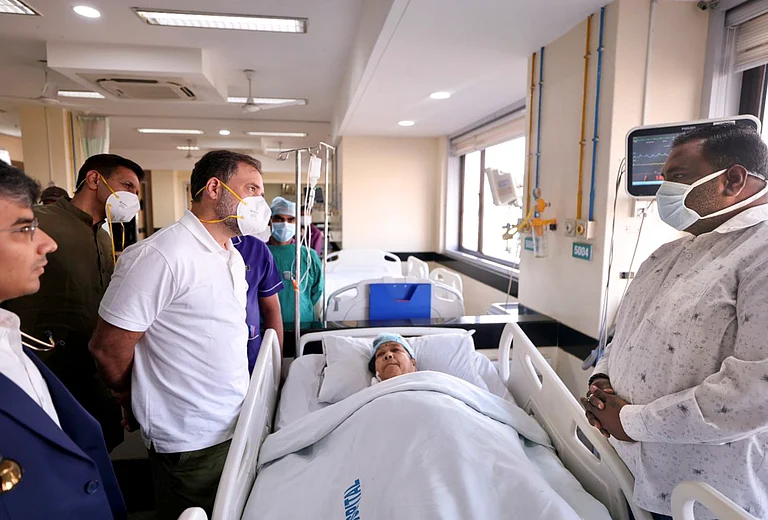The Indian courts issuing back-to-back orders based on ‘Hindutva texts’ raises questions about the Judiciary’s commitment to the Constitutional principles. The latest is the Gujarat High Court’s oral reference about adolescent pregnancy being approved in Manusmriti while considering a petition for the medical termination of pregnancy of a minor rape survivor.
The counsel of the petitioner —the father of the girl— pressed for the medical termination of the seven-month-old foetus as the girl was a 16-year-old rape survivor. According to Live Law, Justice Samir J Dave said that girls used to deliver before the age of 17.
“Because we are living in the 21st century, ask your mother or great grandmother. Fourteen-fifteen was the maximum age for getting married, the childbirth used to happen before the age of 17. Girls get matured before boys. You will not read it, but do read Manusmriti once for this,” said the bench.
A few days ago, the Allahabad High Court directed the astrology department of Lucknow University to determine whether an alleged rape victim was a ‘mangalik’ by examining her Kundali. (This order was stayed by the Supreme Court in a special sitting on June 3). The bench of Justice Brij Raj Singh of Allahabad High Court was considering the bail plea of a rape accused who refused to marry the girl for the reason that she “had mangal dosha in her kundali”. The girl raised the complaint that the man fraudulently obtained her consent for sex by giving the false promise of marrying her. The counsel for the accused argued that he could not solemnise the marriage because the girl was ‘mangalik’. Singh thus directed the university to examine whether this argument was true.
In 2017, Justice Mahesh Chandra Sharma of Rajasthan High Court passed a direction to declare cow as national animal. He issued this order one day prior to his retirement in May 2017. In the order issued in a civil writ petition for protecting the cows in a goshala in Jaipur, Sharma held, “Keeping in mind that cattle and calves are weak living beings, Hindus have a deep devotion towards the cow, and Nepal, being a Hindu state, under its new Constitution, has declared cow as their national animal. Also, agriculture and animal husbandry are the primary contributors to the Indian economy. Along with this, keeping in mind under Articles 48 and 51A (g) of the constitution, providing cows the status of a legal entity, it is expected of this government to declare cow as the national animal.”
In March 2023, the Allahabad High Court too “hoped that the Central Government would take appropriate steps to ban cow slaughter in the country and to declare cow as ‘protected national animal’”. The bench of Justice Shamim Ahmad observed that the origin of the veneration of the cow can be traced to Vedic period and anyone who kills cow and allows others to kill them “is deemed to rot in hell”. He made these observations while considering a quash petition by one Mohammad Abdul Khaliq, who was accused of cow slaughtering. The quash petition was dismissed.
Adopting Manusmriti as a referral text is nothing new in Indian Judiciary. It has been a quite common practice to quote Vedas and scriptures such as Manusmriti while hearing cases related to Hindu rights, family disputes, and inheritance. On the other hand, the courts quote Manusmriti even in cases which have nothing to do with Hinduism. Such references often embody highly patriarchal values that go against the principles of the Constitution. For example, the Karnataka High Court quoted verses in a matter having the question of maintenance under Muslim personal law. In Meharunnisa V Sayyid Habib (2014), the Karnataka High Court opens the Judgment as follows:
“I feel it is just and appropriate to start this judgment by quoting a great universal verse in Manusmriti which often referred with regard to the protection of the women, which is being admired with great respects, irrespective of caste, creed, colour and religion: ‘Pita rakshathi kaumare, bhartha rakshathi youvane, putrah rakshathi vrudhapye, na stree swatantryam arhathi’.”
To uphold the right of the wife to get maintenance of Rs 800 a month, the judge quotes versus of Manusmriti that has been interpreted as glorifying patriarchy.
On the contrary, there have been few moments in the history of Indian Judiciary when it upheld the Constitutional morality over Vedic texts.
In the controversial ‘Sabarimala judgment in Indian Young Lawyer’s Association Vs State of Kerala, quoting BR Ambedkar’s critique of Manusmriti, the Supreme Court made the observation that the notions of purity associated with menstruation is a form of untouchability. The Supreme Court observed that “untouchability practices in relation to lower castes, will also apply to the systemic humiliation, exclusion and subjugation faced by women. Prejudice against women based on notions of impurity and pollution associated with menstruation is a symbol of exclusion”.





















